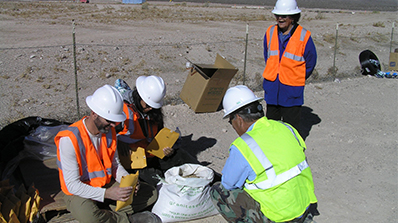Revegetation of the historic 92-acre disposal area at the Nevada National Security Site (NNSS) using recommendations from the people native to the land is underway. The project began in 2016 when the Environmental Management (EM) Nevada Program asked the Consolidated Group of Tribes and Organizations (CGTO) for assistance after previous attempts at revegetating the land were unsuccessful. Now, the EM Nevada Program is moving forward with incorporating the wisdom and traditional ecological knowledge shared by the CGTO that have been passed down among tribal members for thousands of years.
Representatives from the CGTO formed a Tribal Revegetation Committee (TRC) to provide recommendations to the EM Nevada Program after careful study, research, cultural interactions with the land, and consultation with tribal elders. The recommendations provided by the TRC include various seeding and transplant methods utilizing test plots and continual tribal contact with the land as the plants grow. The TRC has recommended a three-year study of the area in order to ensure establishment of the plants, which is consistent with the standard time frame used in ecological studies.
The six CGTO members of the TRC represent three broad ethnic groups with cultural and historic ties to the NNSS and surrounding lands: Southern Paiute, Western Shoshone, and Owens Valley Paiute-Shoshone. Two members from each group are working on the project along with additional expertise from CGTO spokesperson Richard Arnold; ethnoecologist Dr. Jeremy Spoon of Portland State University’s Department of Anthropology; and ecologist Dr. Michael Clifford of Desert Research Institute.
Based on their initial recommendation, tribal representatives observed the first planting last fall.
The TRC expressed their commitment to working closely with the EM Nevada Program in helping to restore ecological and cultural balance to the land. “We are the voices of the land who speak of its importance and desire to maintain ecological balance in accordance to tribal traditions,” Arnold says. Arnold explains that tribal people have been on the land for thousands of years and witnessed many changes, including the separation of tribal people from the land where they were created. “When we are reunited, the land welcomes our return so the healing can begin,” Arnold says.
The project continues in 2018 with a planned spring planting. The TRC recommendations include regular monitoring by the CGTO representatives as well as other tribal members, including young adults. These young tribal members will be encouraged to assist in the project, to help pass on tribal ecological knowledge for generations to come.
For the EM Nevada Program, the project demonstrates a commitment to consider tribal perspectives and concerns when completing environmental management tasks. “The input of culturally affiliated tribes is invaluable to the EM Nevada Program as we carry out our mission to ensure the protection of the public and the environment from the effects of historic nuclear testing. The revegetation project is part of a continuing effort to incorporate tribal involvement in EM missions,” says Rob Boehlecke, program manager, EM Nevada Program.

